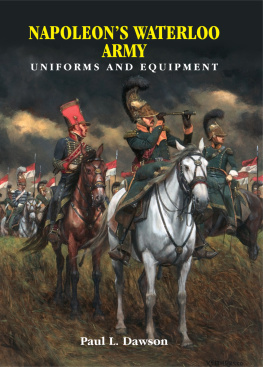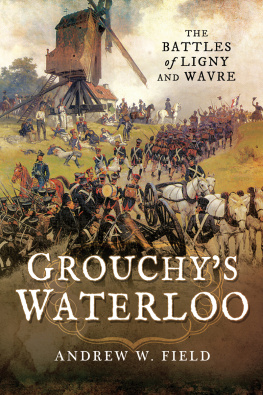MARSHAL NEY AT QUATRE BRAS
New Perspectives on the Opening Battle of the Waterloo Campaign
This edition published in 2017 by Frontline Books,
an imprint of Pen & Sword Books Ltd,
47 Church Street, Barnsley, S. Yorkshire, S70 2AS
Copyright Paul L Dawson
The right of Paul L Dawson to be identified as the author of this work has been asserted by him in accordance with the Copyright, Designs and Patents Act 1988.
ISBN: 978-1-52670-071-1
eISBN: 978-1-52670-073-5
Mobi ISBN: 978-1-52670-072-8
All rights reserved. No part of this publication may be reproduced, stored in or introduced into a retrieval system, or transmitted, in any form, or by any means (electronic, mechanical, photocopying, recording or otherwise) without the prior written permission of the publisher. Any person who does any unauthorized act in relation to this publication may be liable to criminal prosecution and civil claims for damages.
CIP data records for this title are available from the British Library
For more information on our books, please visit
www.frontline-books.com
email
or write to us at the above address.
Introduction
M arshal Ney was a French soldier. He served during both the French Revolutionary and Napolonic Wars. Created Marshal of the Empire by Napolon in 1804, he was known as Le Rougeaud (red faced or ruddy) by his men. Following the Russian campaign, he became known as le Brave des Braves (the bravest of the brave) by Napolon. His career is well known by many historians and wargamers. Today, he is perhaps best remembered as the rearguard commander in Russia, and for leading the massed ranks of glittering cuirassiers to death and glory at Waterloo.
Many have sought to find reasons for why Napolon lost the Battle of Waterloo, as if to shift the blame from the emperor to other factors. Marshal Ney, Marshal Grouchy and Marshal Soult have all been blamed for the defeat. The truth is, however, that the British army was better fed, better equipped and better trained, and Napolon was outgeneraled by the Duke of Wellington. The uncomfortable truth is that the Arme du Nord fought well, but it was bettered by Wellingtons infantry; British, Dutch-Belgian, Nassau, Hanoverian and Prussian. There was no great conspiracy theory for the defeat of Napolon on the part of the French. Napolon had lost battles and campaigns before (Leipzig being a case in point) and had had the time to regenerate a new army and renew the fighting. In 1815, the Allies had learned that the only way to stop Napolon running back to Paris and building a new army (as he had done in 1812, and twice in 1813) was to harass his army to the point of exhaustion and not give Napolon any breathing space. The pursuit of the defeated French after Waterloo cemented the Allied victory. It was a total defeat as the Prussians had suffered in 1806. Napolons grip on power in 1815 was already shaky, and news of the defeat resulted in political intrigue to remove him from power, as had occurred previously with the Malet Plot of 1812. What happened politically in 1815 had occurred in 1812 and 1814, and reflected Napolons own coup in 1799.
However, many still consider Ney, like Grouchy, to be a major factor in Napolon being out-generaled, as it were, at Waterloo. This book seeks to evaluate Neys actions in the Hundred Days campaigns, and assess if he was culpable for the defeat. Our study is based on two forms of evidence: personal testimony and empirical hard data. What follows is a discussion of these sources to enable the reader to understand the strengths and weaknesses of the material used in the creation of a narrative about Napolons last army. The material used has undergone a variety of processes before it was read by the author. Not all the archival paperwork prepared in 1815 has survived to the current day. Not all written memoirs of participants have survived. Those cited here are just those the author could identifymany more may exist in private collections, museums and libraries, and they may well tell a different narrative from that presented here. The narrative has been constructed from the sources available to the author.
In creating our narrative, we have endeavoured to let the primary sources speak for themselves without having to fit what they say into a superficial construct created by other authors. We must be aware, however, of the limitations and failings of these memoirs as a source of empirical data. The memoir, as Paul Fussell has established, occupies a place between fiction and autobiography. Thus, a lot of the letters we use are partly real recollections from first-hand experience added to, and expanded with, what the writer has learned since the events took place.
One of the most cited works about Ney and the Hundred Days is Duc dElchingens Documents inedits sur la campagne de 1815 , which was written to restore the reputation of Marshal Ney by his son. The Service Historique at Vincennes preserves the original manuscript copy of the book dated 1837. Of the documents presented, a good number can be cross-referenced to the register of orders issued by Marshal Soult and General Reille. Where the orders can be cross-referenced, the copies made by Neys son are, in all cases, word-for-word copies of the originals, so we can have some degree of confidence in the material collected overall. However, a lot of the material cannot be cross-checked with documents written in 1815. The Service Historique also preserves a great number of documents written during the campaign. These documents, as well as Reilles and Soults order registers, have never been translated and used in an English-language study of Quatre-Bras. In some cases, the documents have not even been published before in French. In some cases though, many letters and orders cited as being from 16 June are, in reality, perhaps forgeries as we shall see. Therefore, with a large corpus of archive material never used in the study of the battle before we can present a new narrative of Quatre-Bras from the French side. The two most recent studies of the battle by Andrew Fields and Mike Robinson are excellent introductions to the battle, but are both deeply flawed by not using original archive documents and instead are based, for the French forces, on easily accessible published texts. Thus, the study of the battle is not advanced as the same source material is used time and again without any thorough research being conducted on the French participants. With this book I have addressed this issue. These archive sources, coupled with using (for the first time) the actual day-by-day casualty figures from the campaign, have allowed me to write a new history of Quatre-Bras, to reveal the true story of Marshal Ney on 16 June.
We must note that in all correspondence written between 15 to 17 June that what we know as Quatre-Bras was referred to as Trois-Bras or Three-Arms. But, for convenience, we use the incorrect term Quatre-Bras to describe the locality as this term is ingrained in the history of the campaign.











